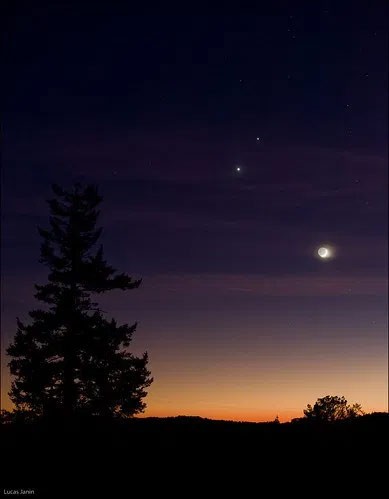Comment récupérer laccès au disque dur, corriger lerreur dimpossibilité douvrir le disque dur

Dans cet article, nous vous expliquerons comment récupérer l'accès à votre disque dur en cas de panne. Suivez-nous !
What are the evening star and the morning star? Here's what you need to know about the evening star and the morning star .
Originally, the terms “morning star” and “evening star” were applied only to the brightest planet of all, Venus. It was much brighter than any actual star in the sky and did not appear to twinkle. Instead, it shone with a steady silvery light. The fact that Venus was a wandering star soon became apparent to ancient skywatchers, who noticed its shift back and forth from the early morning of the eastern sky to the early evening of the western sky. Nicolas Camille Flammarion, a prominent French astronomer of the late 19th and early 20th centuries, called Venus the “Shepherd’s Star.” Many people preferred to call Venus the “night light of the sky.” So one can easily understand the origin of the terms evening star and morning star if one considers Venus alone.
Venus is closer to the Sun than the Earth, so there are times when it will be located to the west of the Sun. At that time, we will observe from Earth that the hottest planet in the solar system will rise in the east at dawn, earlier than the Sun, and people still call it the Morning Star.

On the contrary, there are times when Venus is located to the East of the Sun. At that time, if we observe to the West at a time after the Sun has set for a while, we will see this planet appear and people call it the Evening Star.
In addition to Venus, the phenomenon of a planet appearing alternately at dawn for several months, disappearing for a while, and then reappearing also occurs with Mercury, the planet closest to the Sun. However, because Mercury is farther from Earth, smaller than Venus, and obscured by sunlight, it is more difficult to observe and is less noticed.

Venus is the second planet in the Solar System and also the hottest planet. Venus is almost the same size and mass as Earth. The diameter of the hottest planet in the Solar System is 12,092 km (just 650 km less than Earth's) and its mass is 81.5% of Earth's mass.
The distance from Earth to Venus is 2.3 light minutes, about 41 million km.
With Mercury and Venus, however, there was never any such ambiguity, since they were never very far from the Sun. Because they orbited the Sun closer than Earth, Mercury and Venus were called the “lower” planets. In fact, in pre-Christian times, both planets had dual identities—two names—because people did not initially realize that they appeared on one side of the Sun and then the other. Mercury was called “Apollo” when it shone in the morning and “Hermes” when it appeared in the evening sky; Venus was “Phosphorus” in the morning and “Hesperus” in the evening. We can thank Pythagoras around the 5th century BC for showing that the latter two objects were actually one.
So, in general, when either of these planets is elongated westward from the Sun, it is a "morning star"; when elongated eastward, it is an "evening star". When they are more or less aligned with the Sun as seen from our Earthly perspective, they will transition from evening to morning, or vice versa:
When Mercury or Venus pass between the Sun and Earth, we say they are in their lower conjunction and move from “evening star” to “morning star”. When the stellar alignment is such that they appear almost in a straight line beyond the far side of the Sun as seen from Earth, we say they are in their higher conjunction; that is, when they move from “morning star” to “evening star”.
Dans cet article, nous vous expliquerons comment récupérer l'accès à votre disque dur en cas de panne. Suivez-nous !
À première vue, les AirPods ressemblent à n'importe quel autre écouteur sans fil. Mais tout a changé avec la découverte de quelques fonctionnalités peu connues.
Apple a présenté iOS 26 – une mise à jour majeure avec un tout nouveau design en verre dépoli, des expériences plus intelligentes et des améliorations des applications familières.
Craving for snacks but afraid of gaining weight? Dont worry, lets explore together many types of weight loss snacks that are high in fiber, low in calories without making you try to starve yourself.
Rest and recovery are not the same thing. Do you really need rest days when you schedule a workout? Lets find out!
Les étudiants ont besoin d'un ordinateur portable spécifique pour leurs études. Il doit être non seulement suffisamment puissant pour être performant dans la filière choisie, mais aussi suffisamment compact et léger pour être transporté toute la journée.
L'ajout d'une imprimante à Windows 10 est simple, bien que le processus pour les appareils filaires soit différent de celui pour les appareils sans fil.
Comme vous le savez, la RAM est un composant matériel essentiel d'un ordinateur. Elle sert de mémoire pour le traitement des données et détermine la vitesse d'un ordinateur portable ou de bureau. Dans l'article ci-dessous, WebTech360 vous présente quelques méthodes pour détecter les erreurs de RAM à l'aide d'un logiciel sous Windows.
Refrigerators are familiar appliances in families. Refrigerators usually have 2 compartments, the cool compartment is spacious and has a light that automatically turns on every time the user opens it, while the freezer compartment is narrow and has no light.
Wi-Fi networks are affected by many factors beyond routers, bandwidth, and interference, but there are some smart ways to boost your network.
Si vous souhaitez revenir à la version stable d'iOS 16 sur votre téléphone, voici le guide de base pour désinstaller iOS 17 et rétrograder d'iOS 17 à 16.
Le yaourt est un aliment merveilleux. Est-il bon de manger du yaourt tous les jours ? Si vous mangez du yaourt tous les jours, comment votre corps va-t-il changer ? Découvrons-le ensemble !
Cet article présente les types de riz les plus nutritifs et comment maximiser les bienfaits pour la santé du riz que vous choisissez.
Établir un horaire de sommeil et une routine de coucher, changer votre réveil et ajuster votre alimentation sont quelques-unes des mesures qui peuvent vous aider à mieux dormir et à vous réveiller à l’heure le matin.
Get Bathroom Tower Defense Roblox game codes and redeem them for exciting rewards. They will help you upgrade or unlock towers with higher damage.













